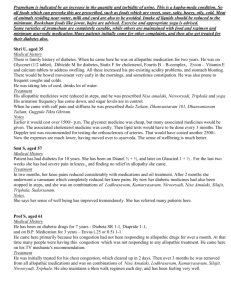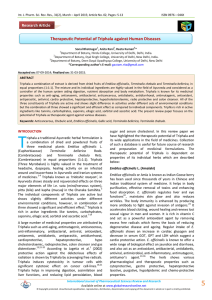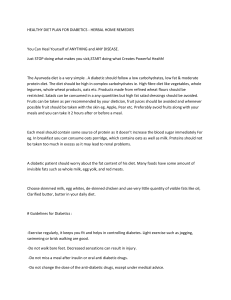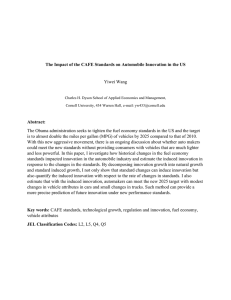Document 13308840
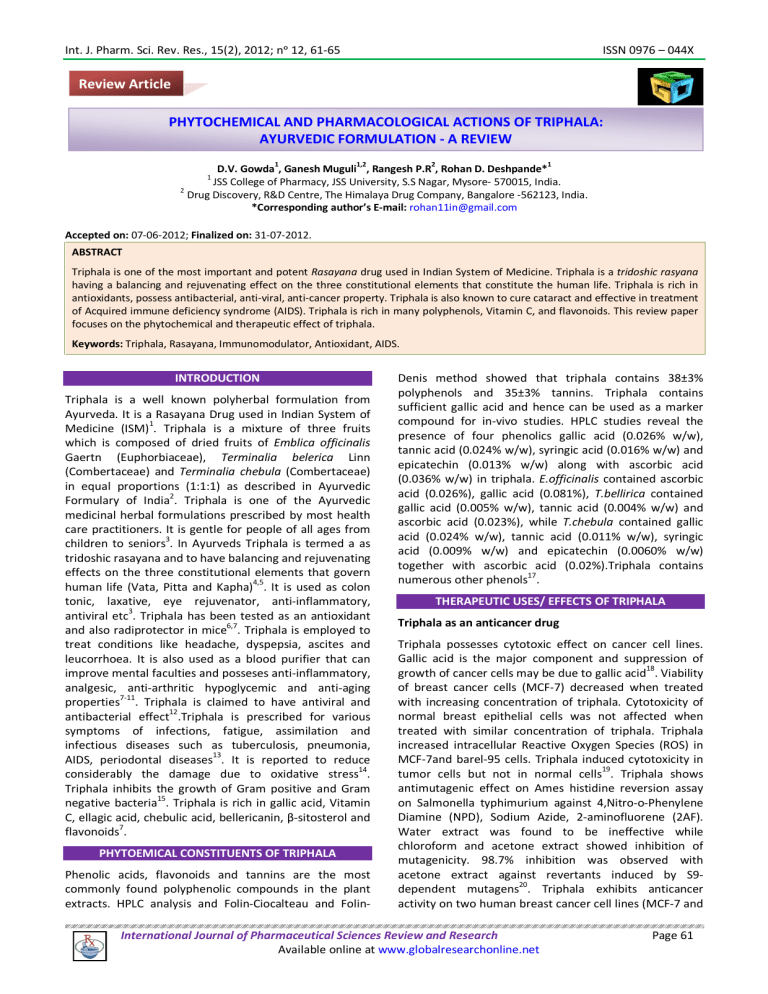
Int. J. Pharm. Sci. Rev. Res., 15(2), 2012; n ᵒ 12, 61-65 ISSN 0976 – 044X
Review Article
PHYTOCHEMICAL AND PHARMACOLOGICAL ACTIONS OF TRIPHALA:
AYURVEDIC FORMULATION - A REVIEW
D.V. Gowda
1
, Ganesh Muguli
1,2
, Rangesh P.R
2
, Rohan D. Deshpande*
1
1
JSS College of Pharmacy, JSS University, S.S Nagar, Mysore- 570015, India.
2
Drug Discovery, R&D Centre, The Himalaya Drug Company, Bangalore -562123, India.
*Corresponding author’s E-mail: rohan11in@gmail.com
Accepted on: 07-06-2012; Finalized on: 31-07-2012.
ABSTRACT
Triphala is one of the most important and potent Rasayana drug used in Indian System of Medicine. Triphala is a tridoshic rasyana having a balancing and rejuvenating effect on the three constitutional elements that constitute the human life. Triphala is rich in antioxidants, possess antibacterial, anti-viral, anti-cancer property. Triphala is also known to cure cataract and effective in treatment of Acquired immune deficiency syndrome (AIDS). Triphala is rich in many polyphenols, Vitamin C, and flavonoids. This review paper focuses on the phytochemical and therapeutic effect of triphala.
Keywords: Triphala, Rasayana, Immunomodulator, Antioxidant, AIDS.
INTRODUCTION
Triphala is a well known polyherbal formulation from
Ayurveda. It is a Rasayana Drug used in Indian System of
Medicine (ISM)
1
. Triphala is a mixture of three fruits which is composed of dried fruits of Emblica officinalis
Gaertn (Euphorbiaceae), Terminalia belerica Linn
(Combertaceae) and Terminalia chebula (Combertaceae) in equal proportions (1:1:1) as described in Ayurvedic
Formulary of India
2
. Triphala is one of the Ayurvedic medicinal herbal formulations prescribed by most health care practitioners. It is gentle for people of all ages from children to seniors
3
. In Ayurveds Triphala is termed a as tridoshic rasayana and to have balancing and rejuvenating effects on the three constitutional elements that govern human life (Vata, Pitta and Kapha)
4,5
. It is used as colon tonic, laxative, eye rejuvenator, anti-inflammatory, antiviral etc
3
. Triphala has been tested as an antioxidant and also radiprotector in mice
6,7
. Triphala is employed to treat conditions like headache, dyspepsia, ascites and leucorrhoea. It is also used as a blood purifier that can improve mental faculties and posseses anti-inflammatory, analgesic, anti-arthritic hypoglycemic and anti-aging properties
7-11
. Triphala is claimed to have antiviral and antibacterial effect
12
.Triphala is prescribed for various symptoms of infections, fatigue, assimilation and infectious diseases such as tuberculosis, pneumonia,
AIDS, periodontal diseases
13
. It is reported to reduce considerably the damage due to oxidative stress
14
.
Triphala inhibits the growth of Gram positive and Gram negative bacteria
15
. Triphala is rich in gallic acid, Vitamin
C, ellagic acid, chebulic acid, bellericanin, β -sitosterol and flavonoids
7
.
PHYTOEMICAL CONSTITUENTS OF TRIPHALA
Phenolic acids, flavonoids and tannins are the most commonly found polyphenolic compounds in the plant extracts. HPLC analysis and Folin-Ciocalteau and Folin-
Denis method showed that triphala contains 38±3% polyphenols and 35±3% tannins. Triphala contains sufficient gallic acid and hence can be used as a marker compound for in-vivo studies. HPLC studies reveal the presence of four phenolics gallic acid (0.026% w/w), tannic acid (0.024% w/w), syringic acid (0.016% w/w) and epicatechin (0.013% w/w) along with ascorbic acid
(0.036% w/w) in triphala. E.officinalis contained ascorbic acid (0.026%), gallic acid (0.081%), T.bellirica contained gallic acid (0.005% w/w), tannic acid (0.004% w/w) and ascorbic acid (0.023%), while T.chebula contained gallic acid (0.024% w/w), tannic acid (0.011% w/w), syringic acid (0.009% w/w) and epicatechin (0.0060% w/w) together with ascorbic acid (0.02%).Triphala contains numerous other phenols
17
.
THERAPEUTIC USES/ EFFECTS OF TRIPHALA
Triphala as an anticancer drug
Triphala possesses cytotoxic effect on cancer cell lines.
Gallic acid is the major component and suppression of growth of cancer cells may be due to gallic acid
18
. Viability of breast cancer cells (MCF-7) decreased when treated with increasing concentration of triphala. Cytotoxicity of normal breast epithelial cells was not affected when treated with similar concentration of triphala. Triphala increased intracellular Reactive Oxygen Species (ROS) in
MCF-7and barel-95 cells. Triphala induced cytotoxicity in tumor cells but not in normal cells
19
. Triphala shows antimutagenic effect on Ames histidine reversion assay on Salmonella typhimurium against 4,Nitro-o-Phenylene
Diamine (NPD), Sodium Azide, 2-aminofluorene (2AF).
Water extract was found to be ineffective while chloroform and acetone extract showed inhibition of mutagenicity. 98.7% inhibition was observed with acetone extract against revertants induced by S9dependent mutagens
20
. Triphala exhibits anticancer activity on two human breast cancer cell lines (MCF-7 and
International Journal of Pharmaceutical Sciences Review and Research Page 61
Available online at www.globalresearchonline.net
Int. J. Pharm. Sci. Rev. Res., 15(2), 2012; n ᵒ 12, 61-65 ISSN 0976 – 044X
T47 D) differing in p53 status. MCF 7 with wild type p53 was more sensitive to triphala than T47 D which is p53 negative. Exogenous addition of antioxidants, glutathione
(GSH) and N-Acetyl Cysteine (NAC) inhibited anti proliferative ability of Triphala in MCF 7 and T47 D cells.
Triphala induced dose and time dependent increase in intracellular reactive oxygen species in both the cell lines.
The sensitivity of the cells to triphala depends on their p53 status
21
. Triphala inhibits the growth of human pancreatic cancer cells in cellular and in vivo model.
Survival of cells was significantly reduced when capan-2 cells were exposed to triphala for 24 hours. Triphala when orally administered at dose of 50 mg/Kg or 100 mg/Kg suppressed growth of capan-2 pancreatic tumor xenografts
22
. Triphala has a chemoprotective role against
1,2 –Dimethylhydrazine, Dihydrochloride induced cancer, by decreasing lipid peroxidation activity of lactate dehydrogenase (LDH), increase in level of reduced glutathione (GSH); it prevents peroxidative damage
23
.
Triphala reduces tumor incidence by increasing the antioxidant status of animals. Triphala reduces benzo(a) pyrene [B(a)P] induced forestomach papillomagensis in mice. It reduces tumor incidence by 77.77% in short term treatment and by 66.66% in long term treatment groups
24
.
Triphala possesses radioprotective effect and delays onset of mortality, reduced radiation sickness symptoms when interperitonially administered to ϒ - radiation subjected mice. Triphala exhibits protection at a dosage of 12.5 mg/Kg and is non-toxic up to a dosage of 240 mg/Kg)
7
. Triphala reduces mortality by 60 % when fed at a dose of 1g/Kg body weight for 7 days prior to whole body
ϒ -irradiation at 7.5 Gy followed by post-irradiation feeding for 7 days. There was an increase in xathine oxidoreductase activity and decrease in superoxide dismutase activity in the intestine of mice exposed to whole body ϒ -irradiation
25
.
Antioxidant Activity of Triphala
Triphala is effective in inhibiting ϒ -radiation induced damage in microsomal lipids and plasmid pBR 322 DNA.
Triphala is rich in polyphenols (38±3%) and tannins
(35±3%). Polyphenolic contents in triphala are responsible for the antioxidant and radioprotecting ability, reduce the oxidative stress by converting reactive oxygen free radicals to non-reactive products
16
. Triphala significantly prevents cold-stress induced oxidative stress. Cold stress induced oxidative stress is measured by Lipid
Peroxidation (LPO), enzymatic Superoxide Dismutase
(SOD), Catalase (CAT), non-enzymatic (Vitamin C) antioxidation status. Administration of Triphala
(1g/Kg/body weight/48 days) prevents Cold Stress induced oxidative stress and elevation in LPO and
Corticosterone levels. The antioxidant property can be correlated to prevention of cold stree induced oxidative stress
26
. Triphala and the individual ingredients of triphala effectively inhibit ϒ -radiation induced strand break formation in plasmid DNA. They inhibit radiation induced lipid peroxidation and possess ability to scavenge free radicals like DPPH and superoxide. Triphala mixture is more effective as it possess combined activity of all the three ingredients
27
. Superoxide radical scavenging activity of triphala using xanthine and xanthine oxidase activity showed that in addition to reacting with superoxide radical, triphala also inhibited uric acid formation.
Triphala is rich in phenols/polyphenols (38±3%), tannins
(35±3%), flavonoids were absent. HPLC analysis revealed that gallic acid content was 73±5 mg/g and increased to
150±5mg/g upon acid hydrolysis
28
.
Triphala against Stress
Triphala supplementation has a protective effect against stress. Triphala administration for 48 days (1g/kg/animal body weight) prevents cold stress induced behavioral and biochemical abnormalities like increase in immobilization, with decrease in rearing, grooming and ambulation behavior, significant increase in lipid peroxidation (LPO) and corticosterone levels
29
.Triphala prevents noise-stress induced changes in antioxidant and cell mediated immune response in rats. Changes induced by noise stress at 100 dB for 4 hour/d/15 days were controlled by
Triphala at 1g/Kg/body weight/48 days
30
.
Antimicrobial Activity of Triphala
Triphala controls dental plaque, gingival inflammation and microbial growth caused by Streptococcus mutans and Lactobacillus. Triphala controls plaque from baseline and its activity is comparable to commonly available mouthwash Chlorhexidine
31
. Ayurvedic formulations like
Triphala Mashi exhibit antimicrobial activity attributed to phenolic compounds and tannins in triphala. The activity is comparable to that of triphala. It inhibits dosedependent growth of gram positive and gram negative bacteria
32
.Triphala and its individual fruit components have a potent antibacterial action against a wide spectrum of bacterial isolates like seudomonas aeruginosa, Klebsiella pneumonia, Shigella sonnei,
Staphylococcus aureus, vibrio cholera, isolated from HIV infected patients. Triphala and its individual components showed antibacterial effect on both gram –positive and gram-negative bacteria, which suggests the ingress of active phytochemicals through both the bacterial cells walls
33
. Triphala churna has antibacterial activity against various bacterial pathogens. Aqueous extract has activity against S.epidermidis, S.aureus, P.vulgaris, mildly antibacterial against S.typhimurium, B.subtilis and negligible/ no inhibitory effect against E.coli and
E.aerogens. The acetone, ethanol and methanol extracts of triphala churna possess highest antibacterial potential against S.epidermidis, S.aureus, P.vulgaris and no antibacterial activity against E.coli, E.aerogenes and
P.aeruginosa
34
. The three fruits constituting thriphala show potent antibacterial activity against E.coli,
Staphylococcus aureus, Pseudomonas aeruginosa, Proteus
vulgaris, Staphylococcus epidermidis, Salmonella typhii,
Salmonella typhimurium, Enterobacter aerogenes. Daily intake of triphala controls enteric infections in human
International Journal of Pharmaceutical Sciences Review and Research Page 62
Available online at www.globalresearchonline.net
Int. J. Pharm. Sci. Rev. Res., 15(2), 2012; n ᵒ 12, 61-65 ISSN 0976 – 044X beings
35
. Triphala possess antibacterial activity against pathogens like Salmonella, Staphylococcus, Pseudomonas and E.coli, Bacillus isolated from wounds of workers and students. Triphala Mashi formulation has lesser antibacterial activity as compared to Triphala
36
. Triphala inhibits growth of Enterococci which causes nosocomial bacteremia, surgical wound/urinary tract infections.
Triphala exhibited a large zone of inhibition against
Enterococci
37
.
Triphala in wound healing
The ointments prepared from triphala extracts show significant wound closure in vivo. The granulation tissue shows reduced bacterial count, increase in collagen, hexosamine, uronic acid
38
. Collagen sponges incorporated with triphala when used to close wounds showed increase thermal stability, water uptake capability, faster wound closure, improved tissue regeneration.
Epigallocatechin gallate interaction with collagen contributes to this quick wound healing activity
39
.
Triphala as an immunomodulator
Triphala has an immunomodulatory activity when tested using carbon clearance test and Delayed Type
Hypersensitivity (DTH) [Foot Pad Swelling] response.
Triphala Mega extract when administered at 500 mg/Kg and 1000 mg/Kg orally showed an increase in carbon clearance index which reflects enhancement of phagocytic function of mononuclear macrophage and nonspecific immunity. There was an increase in DTH response or cell medicated immunity. Triphala mega extract had an stimulatory effect on T cells. The good immunomodulatory property of triphala could be attributed to flavonoids, alkaloids, tannins, saponin glycosides and phenolic compounds
40
. Triphala inhibited the stress induced by noise (4hour /day for 15 days).
Triphala at a dose of 1g/Kg/day for 48 days, enhanced
Avidity Index (AI), but neutrophil function like adherence, phagocytosis were not altered. Neutrophil function was enhanced in triphala immunized group with a decrease in corticosterone level. Neutrophil function was significantly suppressed followed by increase in corticosterone levels both in noise-stress and noise–stress immunized groups.
The noise stress induced changes were significantly prevented in triphala administered group. Oral administration of triphala stimulates neutrophil functions in immunized rats and stress induced suppression in neutrophil function were prevented by triphala
41
.
Triphala as anti-inflammatory
Triphala when topically administered prevents uveitis induced by intraviteral injection of lipopolysaccharide from Escherichia coli. The inflammation of anterior segment in control groups was significantly higher than in triphala treated groups. Triphala exhibits a protective effect in endotoxin-induced uveitis. The treated groups showed not only significant reduction in severity of clinical signs and also reduction in aqueous humor levels of inflammatory cell, protein content and TNFcompared with that of the control group
Triphala in Arthritis
42
.
α
The efficacy of triphala on monosodium urate crystals induced inflammation for gouty arthritis was compared with no-steroidal anti-inflammatory drug Indomethacin.
Triphala treatment inhibited paw volume, levels of lysosomal enzymes, lipid peroxidation and inflammatory mediator tumour necrosis factorα,β -glucuronidase and lactate dehydrogenase level were reduced. Triphala exerted a strong anti inflammatory effect against goutry arthritis
43
. Triphala (1g/Kg/body weight) was evaluated for its antiarthritic effect against indomethacin (3 mg/Kg/body weight) in arthritis induced rats by Freund’s adjuvant (0.1ml). Levels of lysosomal enzymes, tissue marker enzymes, glycoproteins and paw thickness increased in arthitis induced animals. The physical, biochemical changes observed in arthritic animals were altered significantly to near normal conditions after oral administration of Triphala
44
.
Triphala in other disorders
Triphala ghrita offers protection against cataract. Triphala gritha at a dose of 1080 mg gives protection against delaying the onset and progression of cataract. The anticataract effect may be attributed to antioxidant activity of gallic acid, ellagic acid and ascorbic acid
45
.
Triphala pocessess enteroprotective effect against methotrexate induced intestinal damage (12 mg/Kg, orally for 4 days to albino rats). Triphala formulations prepared by mixing 1:1:1 of T.chebula, T.bellirica and
E.officinalis and 1:2:4 proportions of the three ingredients, both exhibited enteroprotective effect. Both the formulations at a dose of 540 mg/kg significantly restored the depleted protein level in brush border membrane of intestine, phospholipids and glutathione content and decreased the mycloperoxidase and xanthine oxidase level in intestinal mucosa. Triphala unequal formulation showed decrease in permeation clearance of phenol red, level of disaccharidase in brush border membrane vesicles and lipid peroxidation content of intestinal mucosa. Triphala unequal formulation exhibits more protection than equal formulation
46
. Triphala and
Triphala Mashi at a dose of 200, 400, 800 mg/kg when administered to castor–oil induced diarrhoeal rats, exhibited an increase in first defecation time, cumulative fecal weight and intestinal transit time. Aqueous and alcoholic extracts of Triphala and Triphala Mashi are safe upto a dose of 1750 mg/Kg, when evaluated for acute oral toxicity
47
.Triphala when administered repeatedly is effective in treating haloperidol induced (1mg/Kg) catalepsy. In acute cases, the aqueous extract of triphala reduced cataleptic score after latency of 60 minutes. The effect of triphala on cataleptic score in both acute and chronic cases were comparable to that produced by standard drug scopolamine
48
.Triphala possess significant antidiabetic activity. Triphala causes normalization of
Fasting Plasma Glucose (FPG) induced by high fructose
International Journal of Pharmaceutical Sciences Review and Research Page 63
Available online at www.globalresearchonline.net
Int. J. Pharm. Sci. Rev. Res., 15(2), 2012; n ᵒ 12, 61-65 ISSN 0976 – 044X diet in rat model. Triphala/the individual ingredients possess significant antidiabetic activity
49
. Triphala is associated with hyperlipidemic effect on hypercholesteremic induced rats. There is a increase in total cholesterol, LDL (Low d.Lipoprotein) and VLDL (Very
Low d.Lipoprotein) and free fatty acid in hypercholestermine rats were reduced in triphala treated hypercholesteremic mice
50
. Triphala also possess an effective antiplaque activity. The ethonolic extract of the formulation has higher antioxidant activity and inhibits
Streptococcus mutans. Triphala extract inhibits the biofilm formation and protects gum cells due to antioxidant activity
51
.
CONCLUSION
Triphala is one of the most important rasayana drugs commonly used in Ayurvedic system of medicine.
Bhavprakash Nigantu mentions triphala to be a mixture of equal proportions of three fruits namely; Emblica
officinalis Gaertn (Euphorbiaceae), Terminalia belerica
Linn (Combertaceae) and Terminalia chebula
(Combertaceae)
52
. According to Charaka Samhita daily consumption of the rasayana drug triphala for a period of one year makes a person survive for hundred years without any illness. Triphala is an esteemed drug in India which has been prescribed for centuries to cure a wide range of ailments. Triphala is a polyherbal formulation and the mechanism of action of polyherbals/herbal drugs and their extracts differ in many respects from that of the synthetic drugs or single substances
53
.
Triphala is effective in curing a wide range of ailments. Its potency as an anti-cancer drug, antibacterial, antiinflammatory and in treatment of arthritis, stress, and cataract is all well studied and proven. As there is lot of adulteration and substitution in the herbal market more studies and parameters for Quality Control of the individual ingredients and the compound formulation triphala needs to be established and carried out so as to ensure reliability and reproducibility of the formulation.
REFERENCES
1.
Govindarajan R, Vijaykumar M, Pushpangadan P. Antioxidant approach to disease management and the role of Rasayan herbs of
Ayurveda; Journal of Ethnopharmacology, 99, 2005, 165-178.
2.
The Ayurvedic Formulary of India, Part –II, Department of Indian
System of Medicine and Homeopathy, New Delhi; 2002.
3.
Khopde SM, Priyadarsini KI, Mohan H, Gawandi VB, Stav JG,
Yakhim JV, et al. Characterizing the antioxidant activity of amla
(Phyllanthus embelica) extract. Current Science, 81, 2001, 185-190.
4.
Sharma RK, Dash B, Carka Samhita volume –II, Varanasi, India,
Chowkamba Snaskrit Series, 1998.
5.
Kaviratna AC, Sharma P, Carka Samhita Volume –I-IV; Delhi, India,
Sri Satguru Publications, 1996.
6.
Vani T, rajani M, Sarkar S, Shishoo CJ. Antioxidant Properties of the
Ayurvedic Formulation Triphala and its constituents, International
Journal of Pharmacognosy, 35, 1997, 313-317.
7.
Jagetia GC, Baliga MS, Malagi KJ, Settukumar KM. The evaluation of the radioprotective effect of Triphala (an Ayurvedic rejuvenating drug) in the mice exposed to gamma-radiation. Phytomedicine, 9,
2002, 99-108.
8.
Rege NN, Thatte UM, Dahanukar SA. Adaptogenic properties of six rasayana herbs used in Ayurvedic medicine, Phytotheraphy
Research, 13, 1999, 275-91.
9.
Mehta BK, Shitut S, Wankhade H. In-vitro antimicrobial efficacy of
Triphala, Fitoterapia, 64, 1993, 371-2.
10.
Vani T, Rajan M, Sarkar S, Shishoo CJ. Antioxidant properties of the
Ayurvedic Formulation Triphala and its constituents. International
Journal of Pharmacognosy. 35, 1997, 313-7.
11.
Kaur S, Arora S, Kaur K, Kumar S. The in vitro, antimutagenic activity of Triphala – an Indian Herbal Drug, Food and Chemical
Toxicology, 40, 2002, 527-34.
12.
Hozumi T, Oyama H. Crude drugs for treating AIDS, Japan Kokai
Tokkyo Koho JP, 09, 1997, 87-185.
13.
El-Mekkawey M, Merelhy M. Inhibitory effects of Egyptian folk medicine on Human Immunodeficiency Virus (HIV) reverse transcriptase. Chem. Pharm. Bull, 43, 1995, 641-648.
14.
Srikumar R, Parthasarathy N, Manikandan S, Narayanan G,
Sheeladevi R. Effect of Triphala on Oxidative stress and on cellmediated immune response against noise stress in rats. Molecular
Cell Biochemistry, 283, 2006, 67-74.
15.
Biradar YS, Jagatap S, Khandelwal KR, Singhania SS. Exploring of
Antibacterial activity of Triphala Mashi- an Ayurvedic Formulation, evid Based complement, Alternat Medicine, 5, 2008, 107-113.
16.
Naik GH, Priyadarsini KI, Mohan H. Evaluation of Antioxidant activity and phytochemical analysis of Triphala, Bhaba Atomic
Research Centre, Founder’s Day Special Issue, 2005.
17.
Singh DP, Govindarajan R, Rawat AKS. High Performance Liquid
Chromatography as a tool for the Chemical Standardisation of
Triphala – an Ayurvedic Formulation, Phytochemical Analysi, 19,
2008, 164-168.
18.
Kaur S, Michael H, Arora S, Harkonen P, Kumar S. The in vitro
Cytotoxic and apoptotic activity of Triphala- an Indian herbal drug,
Journal of Ethnopharmacology, 9(1), 2005, 15-20.
19.
Sandhya T, Lathika KM, Pandey BN, Mishra KP. Potential of traditional Ayurvedic Formulation, Triphala as a novel anticancer drug, Cancer Letters, 231, 2006, 206-214.
20.
Kaur S, Arora S, Kaur K, Kumar S. The in vitro antimutagenic activity of Triphala- an Indian Herbal Drug. Food and Chemical Toxicology,
40(4), 2002, 527-534.
21.
Sandhya T, Mishra KP. Cytotoxic response of breast cancer cell lines, MCF 7 and T 47 D to triphala and its modification by antioxidants. Cancer Letters, 238(2), 2006, 304-313.
22.
Shi Y, Ravi P, Sanjay S, Srivastava K. Triphala inhibits both in vito and in vivo, Xenograft growth of pancreatic tumor cells by inducing apoptosis, BMC Cancer, 8, 2008, 294.
23.
Sharma A, Sharma KK. Chemoprotective Role of Triphala Against
1,2 –Dimethyl Hydrazine Dihydrochloride Induced Carcinogenic
Damage to mouse liver. Indian Journal of Clinical Biochemistry,
26(3), 2011, 290-295.
24.
Deep G, Dhiman M, Rao AR, Kale RK. Chemoprotective potential of
Triphala on benzo (a) pyrene induced forestomach tumorigenesis in murine tumor model system. Journal of Experimental and
Clinical Cancer Research, 24(4), 2005, 555-563.
25.
Sandhya T, Lathika KM, Pandey BN, Bhilwade HN, Chaubey RC,
Priyadarsini KI, et al. Protection against radiation oxidative damage in mice by Triphala. Mutation Research/Genetic Toxicology and
Environmental Mutagenesis 609(1), 2006, 17-25.
26.
Dhanalakshmi S, Srikumar R, Manikandan S, Parthasarathy NJ, Devi
RS. Antioxidant Property of Triphala on Cold Stress Induced
International Journal of Pharmaceutical Sciences Review and Research Page 64
Available online at www.globalresearchonline.net
Int. J. Pharm. Sci. Rev. Res., 15(2), 2012; n ᵒ 12, 61-65 ISSN 0976 – 044X
Oxidative stress in Experimental rats. Journal of Health Science,
52(6), 2006, 843-847.
27.
Naik GH, Priyadarsini KI, Bhagirathi RG, Mishra B, Mishra KP,
Banavalikar MM, et al. In vitro, antioxidant studies and free radical reactions of triphala, an Ayurvedic formulation and its constituents. Phytotheraphy Research, 19, 2005, 582-586.
28.
Naik GH, Priyadarsini KI, Mohan H. Free radical scavenging reactions and phytochemical analysis of triphala, an Ayurvedic formulation. Current Science, 90(8), 2006, 1100-1105.
29.
Dhanalakshmi S, Devi RS, Srikumar R, Sundaramahalingam,
Manikandan, Thagaraj R, Protective effect of Triphala on Coldstress induced Behavioral and Biochemical abnormalities in Rats,
Yakugaku Zassh, 127(11), 2007, 1863-1867.
30.
Srikumar, Ramasundaram, Parthasarathy, Jeya N, Manikandan,
Sundaramagalingam, et ai. Effect of Triphala on oxidative stress and on cell medicated immune response against noise stress in rats. Molecular and Cellular Biochemistry, 283(1&2), 2006, 67-74.
31.
Neeti Bajaj, Shobha Tandon. The effect of Triphala and
Chlorhexidine mouthwash on dental plaque, gingival inflammation and microbial growth. International Journal of Ayurveda Research,
2(1), 2001.
32.
Yogesh, Biradar S, Jagatap S, Khandelwal KR, Singhania SS.
Exploring of Antimicrobial activity of Triphala Mashi-an Ayurvedic formulation. Advance Access Publication e CAM, 5(1), 2008, 107-
113.
33.
Srikumar R, Parthesarathy NY, Shankar EM, Manikandan S,
Vijaykumar R, Thagaraj R, et al. Evalutaion of the growth inhibitory activities of Triphala against common Bacterial Isolates from HIV
Infected patients. Phtyotherapy Research, 21, 2007, 476-480.
34.
Tambekar DH, Dahikar SB, Lahare MD. Antibacterial potentials of some herbal preparation available in India. Research Journal of
Medicine and Medical Sciences, 4(2), 2009, 224-227.
35.
Tambekar DH, Khante BS, Dahikar SB, Zarey VM. Antibacterial properties of contents of triphala: A traditional Indian Herbal preparation, Journal of Microbiology, 1, 2007, 8-12.
36.
Kumar A, Kumar A, Kumar P , Patil S. Antibaterical activity of
Triphala and Triphala Mashi extracts against bacertia isolates from wound infection. Asian Journal of Biochemistry and
Pharamceutical Research, 1(4), 2011, 142-148.
37.
Mahalakshmi K, Prabhakar J, Sukumaran VG. Antibacterial activity of Triphala, GTP and curcumin on Enterococci faecalis.
Biomedicine, 26(3&4) 2006, 43-46.
38.
Kumar MS, Kirulanandan S, Sripriya R, Sehgal PK. Triphala promotes healing of Infected full-thickness dermal wound. Journal
of surgical research, 144, 2008, 94-101.
39.
Kumar MS, Kirulanandan S, Sripriya R, Sehgal PK. Triphala incorporated collagen sponge – A smart Biomaterial for Infected dermal wound healing. Journal of Surgical Research, 158, 2010,
162-170.
40.
Rinki S, Mishra RN. Immunomodulatory activity of triphala mega extratct. International Journal of Research in Pharmaceutical and
Biomedical Sciences, 2(2), 2011, 575-578.
41.
Srikumar R, Narayanaperumal, Parthasarathy J, Devi RS.
Immunomodulatory Activity of Triphala on neutrophil functions.
Biol.Pharm.Bull, 28(8), 2005, 1398-1403.
42.
Gupta SK, Kalaiselvan V, Agarwal SS, Srivastava S, Saxena R.
Prevention of endotoxin-induced uveitis in rabbits by Triphala, an
Ayurvedic formulation. International Journal of Current Biomedical
and Pharmaceutical Research, 1(2), 2011, 20-23.
43.
Sabina EP, Rasool M. An in vivo and in vitro potential of Indian
Ayurvedic herbal formulation Triphala on experimental goutry arthritis in mice. Vascular pharmacology, 48, 2008, 14-20.
44.
Rasool M, Sabina EP. Anti-inflammatory effect of the Indian
Ayurvedic herbal formulation Triphala on adjuvant- induced arthritis in mice. Phtytherapy research, 21(9), 2007, 889-894.
45.
Mahajan KN, Singhai AK, Vadnere GP. Investigation on anticataract activity of Triphala ghrita, E- Journal of Chemistry, 8(3), 2011, 1438-
1443.
46.
Nariya M, Shukla V, Jain S, Ravishankar B. Comparision of enteroprptective efficacy of triphala formulation on methotrexateinduced small intestinal damage in rats.Phytotherapy, 23(8), 2009,
1092-8.
47.
Biradar YS, Singh R, Sharma K, Dhalwal K, Bodhankar SL,
Khandelwal KR. Evaluation of anti-diarrhoeal property and acute toxicity of Triphala Mashi, an Ayurvedic formulation. Journal of
Herbal Pharmacotheraphy, 7(3&4), 2007, 203-12.
48.
Krishna HN, Sudhakar GP, Dorababu P, Pai MR, Colaco N, Vineetha
V. The effect of acute and chronic administration of the aqueous extract of Triphala on haloperidol induced catalepsy in mice,Journal of clinical and Diagnostic Research, 4(1), 2010, 2134-
2138.
49.
Prativadibhayankaram, Venkateshan S, Malhotra S, Pandhi P, Singh
A. Anti-diabetic activity of Triphala, fruit extracts, individually and in combination, in a rat model of insulin resistance. Natural
Product Communications, 3(2), 2008, 251-256.
50.
Saravanan S, Srikumar R, Manikandan, Sundaramalingam,
Parthasarathy, Devi JN, et al. Hypolipidemic effect of Triphala in experimentally induced hypercholesteremic rats. Yakugaku Zasshi,
127(2), 2007, 385-388.
51.
Jagadish L, Anand Kumar VK, Kaviyarasan V. Effect of Triphala on dental bio-film, Indian Journal of Science and Technology, 2(1),
2009, 30-33.
52.
Shastri VD, Bhavaprakashnigantu, Banridas M, Delhi, India (1977).
Vidyalankara J. Charaka samhita by Ayurvedacharya Shri Jaidev
Vidyalankara, Motilal Banarsidass Publishers Pvt.Ltd., New Delhi,
India, 1975.
53.
Jain SK. Medicinal Plants. 1 st
Edition: National Book Trust, New
Delhi, India, 1968.
*******************
International Journal of Pharmaceutical Sciences Review and Research Page 65
Available online at www.globalresearchonline.net
